Spatial Distribution and Growth Patterns of a Common Bivalve Mollusk (Macoma calcarea) in Svalbard Fjords in Relation to Environmental Factors
Simple Summary
Abstract
1. Introduction
2. Materials and Methods
2.1. Study Area
2.2. Sample Collection and Analysis
2.3. Statistical Analysis
3. Results
4. Discussion
5. Conclusions
Author Contributions
Funding
Institutional Review Board Statement
Informed Consent Statement
Data Availability Statement
Acknowledgments
Conflicts of Interest
References
- Kędra, M.; Grebmeier, J.M. Ecology of Arctic Shelf and Deep Ocean Benthos. In Arctic Ecology; Thomas, D.N., Ed.; John Wiley & Sons Ltd.: Hoboken, NJ, USA, 2021; pp. 325–355. [Google Scholar]
- Dvoretsky, V.G.; Dvoretsky, A.G. Checklist of fauna found in zooplankton samples from the Barents Sea. Polar Biol. 2010, 33, 991–1005. [Google Scholar] [CrossRef]
- Mecklenburg, C.W.; Møller, P.R.; Steinke, D. Biodiversity of arctic marine fishes: Taxonomy and zoogeography. Mar. Biodiv. 2011, 41, 109–140. [Google Scholar] [CrossRef]
- Sirenko, B.I. List of species of free-living invertebrates of Eurasian Arctic seas and adjacent deep waters. Explor. Fauna Seas 2001, 51, 1–76. [Google Scholar]
- Bluhm, B.A.; Gradinger, R.; Hopcroft, R.R. Arctic Ocean Diversity synthesis. Mar. Biodivers. 2011, 41, 1–4. [Google Scholar] [CrossRef]
- Dayton, P.K.; Mordida, B.J.; Bacon, F. Polar marine communities. Am. Zool. 1994, 34, 90–99. [Google Scholar] [CrossRef]
- Węsławski, J.M.; Kendall, M.A.; Włodarska-Kowalczuk, M.; Iken, K.; Legeżyńska, J.; Kędra, M.; Sejr, M. Climate change effects on Arctic fjord and coastal macrobenthic diversity-observations and predictions. Mar. Biodivers. 2011, 4, 71–85. [Google Scholar] [CrossRef]
- Dvoretsky, A.G.; Dvoretsky, V.G. Distribution patterns and biological aspects of Strongylocentrotus droebachiensis (Echinoidea: Echinoida) in Russian waters of the Barents Sea: Implications for commercial exploration. Rev. Fish Biol. Fish. 2024, 34, 1215–1229. [Google Scholar] [CrossRef]
- Dvoretsky, A.G.; Dvoretsky, V.G. Cucumaria in Russian waters of the Barents Sea: Biological aspects and aquaculture potential. Front. Mar. Sci. 2021, 8, 613453. [Google Scholar] [CrossRef]
- Boitsov, V.D. Variability Temperature in the Barents Sea and Its Forecasting; PINRO Press: Murmansk, Russia, 2006. (In Russian) [Google Scholar]
- Ozhigin, V.K.; Ivshin, V.A.; Trofimov, A.G.; Karsakov, A.L.; Anciferov, M.Y. The Barents Sea Water: Structure, Circulation, Variability; PINRO: Murmansk, Russia, 2016. [Google Scholar]
- Parkinson, C.L. Spatially mapped reductions in the length of the Arctic sea ice season. Geophys. Res. Lett. 2014, 41, 4316–4322. [Google Scholar] [CrossRef]
- Tsubouchi, T.; Vage, K.; Hansen, B.; Margretha, K.; Larsen, H.; Osterhus, S.; Johnson, C.; Jonsson, S.; Valdimarsson, H. Increased ocean heat transport into the Nordic Seas and Arctic Ocean over the period 1993–2016. Nat. Clim. Chang. 2021, 11, 21–28. [Google Scholar] [CrossRef]
- Polyakov, I.V.; Pnyushkov, A.V.; Alkire, M.B.; Ashik, I.M.; Baumann, T.M.; Carmack, E.C.; Goszczko, I.; Guthrie, J.; Ivanov, V.V.; Kanzow, T.; et al. Greater role for Atlantic inflows on sea-ice loss in the Eurasian Basin of the Arctic Ocean. Science 2017, 356, 285–291. [Google Scholar] [CrossRef] [PubMed]
- Dvoretsky, A.G.; Dvoretsky, V.G. Filling knowledge gaps in Arctic marine biodiversity: Environment, plankton, and benthos of Franz Josef Land, Barents Sea. Ocean Coast. Manag. 2024, 249, 106987. [Google Scholar] [CrossRef]
- Olli, K.; Riser, C.W.; Wassmann, P.; Ratkova, T.; Arashkevich, E.; Pasternak, A. Seasonal variation in vertical flux of biogenic matter in the marginal ice zone and the central Barents Sea. J. Mar. Syst. 2002, 38, 189–204. [Google Scholar] [CrossRef]
- Denisenko, S.G. Biodiversity and Bioresources of Macrozoobenthos of the Barents Sea: Structure and Long-Term Changes; Nauka: St. Petersburg, Russia, 2013. (In Russian) [Google Scholar]
- Renaud, P.E.; Morata, N.; Carroll, M.L.; Denisenko, S.G.; Reigstad, M. Pelagic-benthic coupling in the western Barents Sea: Processes and time scales. Deep-Sea Res. II 2008, 55, 2372–2380. [Google Scholar] [CrossRef]
- Lyubina, O.S.; Strelkova, N.A.; Lubin, P.A.; Frolova, E.A.; Dikaeva, D.R.; Zimina, O.L.; Akhmetchina, O.Y.; Manushin, I.E.; Nekhaev, I.O.; Frolov, A.A.; et al. Modern quantitative distribution of zoobenthos along on the transect “Kola Section”. Trans. Kola Sci. Cent. RAS 2016, 3, 64–91. [Google Scholar]
- Evseeva, O.Y.; Dvoretsky, A.G. New distribution records of the Arctic bryozoan Uschakovia gorbunovi Kluge, 1946 in the Barents and Greenland Seas. J. Mar. Biol. Assoc. UK 2024, 104, e62. [Google Scholar] [CrossRef]
- Wassmann, P.; Reigstad, M.; Haug, T.; Rudels, B.; Carroll, M.L.; Hop, H.; Gabrielsen, G.W.; Falk-Petersen, S.; Denisenko, S.G.; Arashkevich, E.; et al. Food webs and carbon flux in the Barents Sea. Progr. Oceanogr. 2006, 71, 232–287. [Google Scholar] [CrossRef]
- Carroll, M.L.; Denisenko, S.G.; Renaud, P.E.; Ambrose, W.G., Jr. Benthic infauna of the seasonally ice-covered western Barents Sea: Patterns and relationships to environmental forcing. Deep-Sea Res. II 2008, 55, 2340–2351. [Google Scholar] [CrossRef]
- Dikaeva, D.R.; Dvoretsky, A.G. Spatial patterns and environmental control of polychaete communities in the southwestern Barents Sea. Biology 2024, 13, 924. [Google Scholar] [CrossRef]
- Carroll, M.L.; Johnson, B.J.; Henkes, G.A.; McMahon, K.W.; Voronkov, A.; Ambrose, W.G., Jr.; Denisenko, S.G. Bivalves as indicators of environmental variation and potential anthropogenic impacts in the southern Barents Sea. Mar. Pollut. Bull. 2009, 59, 193–206. [Google Scholar] [CrossRef]
- Denisenko, S.G. Structurally-functional characteristics of the Barents Sea zoobenthos. Proc. Zool. Inst. Russ. Acad. Sci. 2004, 300, 43–52. (In Russian) [Google Scholar]
- Cochrane, S.K.J.; Pearson, T.H.; Greenacre, M.; Costelloe, J.; Ellingsen, I.H.; Dahle, S.; Gulliksen, B. Benthic fauna and functional traits along a Polar Front transect in the Barents Sea–Advancing tools for ecosystem-scale assessments. J. Mar. Syst. 2012, 94, 204–217. [Google Scholar] [CrossRef]
- Petersen, G.H. Life cycles and population dynamics of marine benthic bivalves from the Disko Bugt area of West Greenland. Ophelia 1978, 17, 95–120. [Google Scholar] [CrossRef]
- Naumov, A.D. Bivalve molluscs of the White Sea. In Experience of Ecological and Faunistic Analysis; Zoological Institute of RAS: St. Petersburg, Russia, 2006. (In Russian) [Google Scholar]
- Lisitsyna, K.N.; Gerasimova, A.V.; Maksimovich, N.V. Demecological studies of Macoma calcarea (Gmelin) in the White Sea. In XIII All-Russian Conference with International Participation “Study, Rational Use and Protection of Natural Resources of the White Sea”; Pugachev, O.N., Ed.; SPGU: St. Petersburg, Russia, 2017; pp. 123–126. (In Russian) [Google Scholar]
- Gerasimova, A.V.; Filippova, N.A.; Lisitsyna, K.N.; Filippov, A.A.; Nikishina, D.V.; Maximovich, N.V. Distribution and growth of bivalve molluscs Serripes groenlandicus (Mohr) and Macoma calcarea (Gmelin) in the Pechora Sea. Polar Biol. 2019, 42, 1685–1702. [Google Scholar] [CrossRef]
- Noskovich, A.E. The spatial distribution, growth, and reproduction of the bivalve Macoma calcarea (Gmelin, 1791) off the coast of Novaya Zemlya. Russ. J. Mar. Biol. 2021, 47, 47–55. [Google Scholar] [CrossRef]
- Kamenev, G.M.; Kavun, V.Y.; Tarasov, V.G.; Fadeev, V.I. Distribution of bivalve mollusks Macoma golikovi Scarlato and Kafanov, 1988 and Macoma calcarea (Gmelin, 1791) in the shallow-water hydrothermal ecosystem of Kraternaya Bight (Yankich Island, Kuril Islands): Connection with feeding type and hydrothermal activity of Ushishir Volcano. Cont. Shelf Res. 2004, 24, 75–95. [Google Scholar]
- Gerasimova, A.; Maximovich, N. Age-size structure of common bivalve mollusc populations in the White Sea: The causes of instability. Hydrobiologia 2013, 706, 119–137. [Google Scholar] [CrossRef]
- Sirenko, B.I.; Gagaev, S.Y. Unusual abundance of macrobenthos and biological invasions in the Chukchi Sea. Russ. J. Mar. Biol. 2007, 33, 355–364. [Google Scholar] [CrossRef]
- Goethel, C.L.; Grebmeier, J.M.; Cooper, L.W. Changes in abundance and biomass of the bivalve Macoma calcarea in the northern Bering Sea and the southeastern Chukchi Sea from 1998 to 2014, tracked through dynamic factor analysis models. Deep-Sea Res. II 2019, 162, 127–136. [Google Scholar] [CrossRef]
- Dvoretsky, V.G.; Dvoretsky, A.G. Ecology and distribution of red king crab larvae in the Barents Sea: A review. Water 2022, 14, 2328. [Google Scholar] [CrossRef]
- Galkin, Y.I. Long-term changes of the bottom fauna. In Life and Conditions of Its Existence in the Benthic of the Barents Sea; Matishov, G.G., Ed.; KSC USSR AS: Apatity, Russia, 1986; pp. 43–52. (In Russian) [Google Scholar]
- Mokievsky, V.O. Species—Biological Indicators of the State of Arctic Marine Ecosystems. Russian Arctic Sea Atlases; Research Foundation: Moscow, Russia, 2020. (In Russian) [Google Scholar]
- Pavlov, A.K.; Tverberg, V.; Ivan, B.V.; Nilsen, F.; Falk-Petersen, S.; Granskog, M.A. Warming of Atlantic Water in two west Spitsbergen fjords over the last century (1912–2009). Polar Res. 2013, 32, 11206. [Google Scholar] [CrossRef]
- Nilsen, F.; Skogseth, R.; Vaardal-Lunde, J.; Inall, M. A simple shelf circulation model: Intrusion of Atlantic Water on the West Spitsbergen Shelf. J. Phys. Oceanogr. 2016, 46, 1209–1230. [Google Scholar] [CrossRef]
- Skogseth, R.; Olivier, L.L.; Nilsen, F.; Falck, E.; Fraser, N.; Tverberg, V.; Ledang, A.B.; Vader, A.; Jonassen, M.O.; Søreide, J.; et al. Variability and decadal trends in the Isfjorden (Svalbard) ocean climate and circulation—An indicator for climate change in the European Arctic. Prog. Oceanogr. 2020, 187, 102394. [Google Scholar] [CrossRef]
- Evseeva, O.Y.; Dvoretsky, A.G. Shallow-water bryozoan communities in a glacier fjord of West Svalbard, Norway: Species composition and effects of environmental factors. Biology 2023, 12, 185. [Google Scholar] [CrossRef]
- Bloshkina, E.V.; Filchuk, K.V. The present water masses conditions of West Spitsbergen fjords. Arct. Antarct. Res. 2018, 64, 125–140. [Google Scholar] [CrossRef]
- Ivanov, B.V.; Svyashennikov, P.N. Climate system of the Svalbard archipelago. In The State of the Arctic Seas and Territories in the Conditions of Climate Change; Ryabchenko, S.V., Ed.; SAFU Publishing House: Arkhangelsk, Russia, 2014; pp. 28–29. (In Russian) [Google Scholar]
- Błaszczyk, M.; Ignatiuk, D.; Uszczyk, A.; Cielecka-Nowak, K.; Grabiec, M.; Jania, J.A.; Moskalik, M.; Walczowski, W. Freshwater input to the Arctic fjord Hornsund (Svalbard). Polar Res. 2019, 38, 3506. [Google Scholar] [CrossRef]
- Prominska, A.; Cisek, M.; Walczowski, W. Kongsfjorden and Hornsund hydrography—Comparative study based on a multiyear survey in fjords of west Spitsbergen. Oceanologia 2017, 59, 397–412. [Google Scholar] [CrossRef]
- Skogseth, R.; Haugan, P.M.; Jakobsson, M. Watermass transformations in Storfjorden. Cont. Shelf Res. 2005, 25, 667–695. [Google Scholar] [CrossRef]
- Loeng, H. Features of the physical oceanographic conditions of the Barents Sea. Polar Res. 1991, 10, 5–18. [Google Scholar] [CrossRef]
- Schauer, U. The release of brine-enriched shelf water from fjord into the Norwegian Sea. J. Geophys. Res. 1995, 100, 16015–16028. [Google Scholar] [CrossRef]
- Istoshin, Y.V. Marine Hydrometry; Hydrometeorological Publishing House: Leningrad, Russia, 1967. [Google Scholar]
- Chipperfield, P.W. Observation on the breeding and settlement of Mytilus edulis (L.) in the British waters. J. Mar. Biol. Assoc. UK 1953, 32, 449–476. [Google Scholar] [CrossRef]
- Shkorbatov, G.L.; Starobogatov, Y.I. Methods of studying bivalve mollusks. Proc. Zool. Inst. USSR Acad. Sci. 1990, 219, 1–208. [Google Scholar]
- Maksimovich, N.V.; Pogrebov, V.B. Analysis of Quantitative Hydrobiological Materials. Textbook; LGU: Leningrad, Russia, 1986. (In Russian) [Google Scholar]
- Maximovich, N.V.; Guerasimova, A.V. On character of mortality in populations of bivalve mass species in the White Sea. Biol. Commun. 2007, 4, 54–62. (In Russian) [Google Scholar]
- Kennish, M.J.; Olsson, R.K. Effects of thermal discharges on the microstructural growth of Mercenaria mercenaria. Environ. Geol. 1975, 1, 41–64. [Google Scholar] [CrossRef]
- Taylor, A.C.; Brand, A.R. A comparative study of the respiratory responses of the bivalves Arctica islandica (L.) and Mytilus edulis (L.) to declining oxygen tension. Proc. Royal Soc. Lond. B Biol. Sci. 1975, 190, 443–456. [Google Scholar]
- Lisitsyna, K.N.; Gerasimova, A.V. Growth and distribution of bivalve molluscs Macoma calcarea (Gmelin) in the Kara Sea. In Proceedings of the VII International Conference “Marine Research and Education”, Moscow, Russia, 19–22 November 2018; PoliPRESS: Tver, Russia, 2019; pp. 18–21. (In Russian). [Google Scholar]
- Lisitsyna, K.N.; Gerasimova, A.V.; Filippova, N.A. Macoma calcarea (Gmelin, 1791), a poorly studied bivalve, in the Kara Sea: Distribution and growth variability. Mar. Ecol. 2024, 45, e12798. [Google Scholar] [CrossRef]
- Scarlato, O.A. (Ed.) Methods of studying bivalve molluscs. In Proceedings of the Zoological Institute of the Academy of Sciences of the USSR; Zoological Institute of the Academy of Sciences of the USSR: Leningrad, Russia, 1990; Volume 219. (In Russian) [Google Scholar]
- Maximovich, N.V. Statistical comparison of growth curves. Vestnik LGU 1989, 4, 18–25. [Google Scholar]
- Noskovich, A.E. On the diversity of settlements of the bivalve mollusc Macoma calcarea (Bivalvia, Tellinidae) off the coast of Novaya Zemlya. Trans. Kola Sci. Cent. RAS 2020, 5, 116–125. [Google Scholar] [CrossRef]
- Nikiforov, S.L.; Dunaev, N.N.; Politova, N.V. Modern environmental conditions of the Pechora Sea (climate, currents, waves, ice regime, tides, river runoff, and geological structure). Ber. Polarforsch. 2005, 501, 7–38. [Google Scholar]
- Yurgens, E.M. Ecological Characteristics of the Mollusk Macoma balthica (Linne, 1758) in the Southern Part of the Baltic Sea. Ph.D. Thesis, Publishing House of the Russian State University named after I. Kant, Kaliningrad, Russia, 2006. (In Russian). [Google Scholar]
- Zolotarev, V.N. Sclerochronology of Marine Bivalve Mollusks; Naukova Dumka: Kiev, USSR, 1989. (In Russian) [Google Scholar]
- Gerasimova, A.V.; Maksimovich, N.V. On the patterns of the organization of settlements of mass species of bivalve mollusks of the White Sea. Biol. Commun. 2009, 3, 82–97. (In Russian) [Google Scholar]
- Noskovith, A.E. Change in the assessment of the direct bivalve mollusc Macoma calcarea (Bivalvia, Tellinidae) in different regions of the Barents Sea. In Coordinated Ecological and Chemical Studies, Methods and Production Technologies; MSTU Publishing House: Murmansk, Russia, 2018; pp. 372–378. (In Russian) [Google Scholar]
- Pavlova, L.V.; Dvoretsky, A.G.; Frolov, A.A.; Zimina, O.L.; Evseeva, O.Y.; Dikaeva, D.R.; Rumyantseva, Z.Y.; Panteleeva, N.N. The impact of sea ice loss on benthic communities of the Makarov Strait (northeastern Barents Sea). Animals 2023, 13, 2320. [Google Scholar] [CrossRef] [PubMed]
- Mityaev, M.V.; Gerasimova, M.V. Geology-tectonic and geomorphological features of the structure of the Franz-Josef Land Archipelago and modern conditions of sedimentation on the neighboring continental shelf. Trans. Kola Sci. Cent. RAS 2014, 4, 5–60. (In Russian) [Google Scholar]
- Waga, H.; Hirawake, T.; Nakaoka, M. Influences of size structure and post-bloom supply of phytoplankton on body size variations in a common Pacific Arctic bivalve (Macoma calcarea). Polar Sci. 2021, 27, 100554. [Google Scholar] [CrossRef]
- Lundquist, C.J.; Thrush, S.F.; Hewitt, J.E.; Halliday, J.; MacDonald, I.; Cummings, V.J. Spatial variability in recolonisation potential: Influence of organism behaviour and hydrodynamics on the distribution of macrofaunal colonists. Mar. Ecol. Prog. Ser. 2006, 324, 67–81. [Google Scholar] [CrossRef]
- Hunt, H.L.; Maltais, M.J.; Fugate, D.C.; Chant, R.J. Spatial and temporal variability in juvenile bivalve dispersal: Effects of sediment transport and flow regime. Mar. Ecol. Prog. Ser. 2007, 352, 145–159. [Google Scholar] [CrossRef]
- Hunt, H.L. Transport of juvenile clams: Effects of clam species and sediment grain size. J. Exp. Mar. Biol. Ecol. 2004, 312, 271–284. [Google Scholar] [CrossRef]
- Cautain, I.J.; Last, K.S.; McKee, D.; Bluhm, B.A.; Renaud, P.E.; Ziegler, A.F.; Narayanaswamy, B.E. Uptake of sympagic organic carbon by the Barents Sea benthos linked to sea ice seasonality. Front. Mar. Sci. 2022, 9, 009303. [Google Scholar] [CrossRef]
- Reigstad, M.; Carroll, J.; Slagstad, D.; Ellingsen, I.; Wassmann, P. Intra-regional comparison of productivity, carbon flux and ecosystem composition within the northern Barents Sea. Prog. Oceanogr. 2011, 90, 33–46. [Google Scholar] [CrossRef]
- Olafsson, E.B. Contrasting influences of suspension-feeding and deposit-feeding populations of Macoma balthica on infaunal recruitment. Mar. Ecol. Prog. Ser. 1989, 55, 171–179. [Google Scholar] [CrossRef]
- Interstate standard GOST 34088-2017; Guidelines for the Maintenance and Care of Laboratory Animals. Standartinform: Moscow, Russia, 2019.
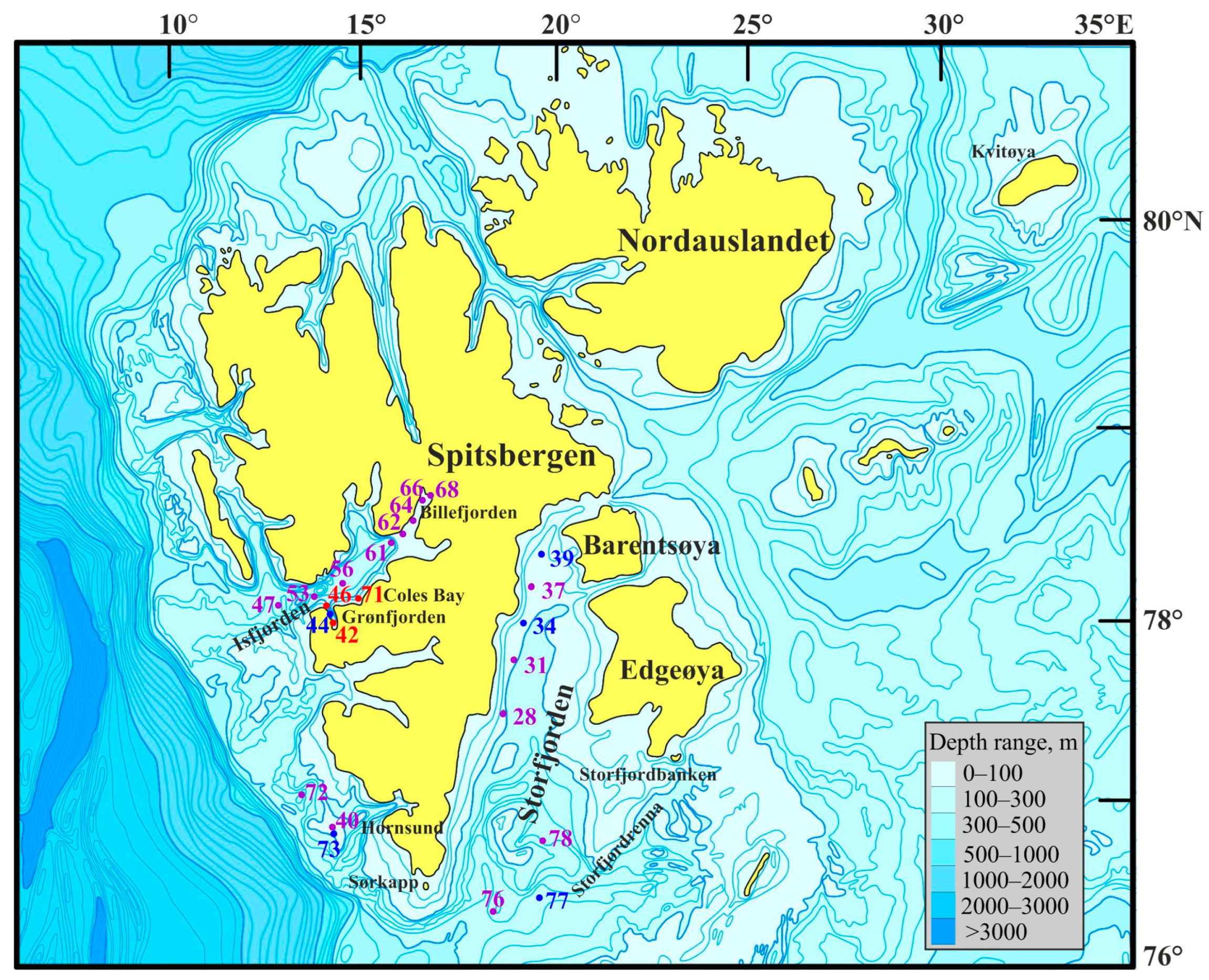
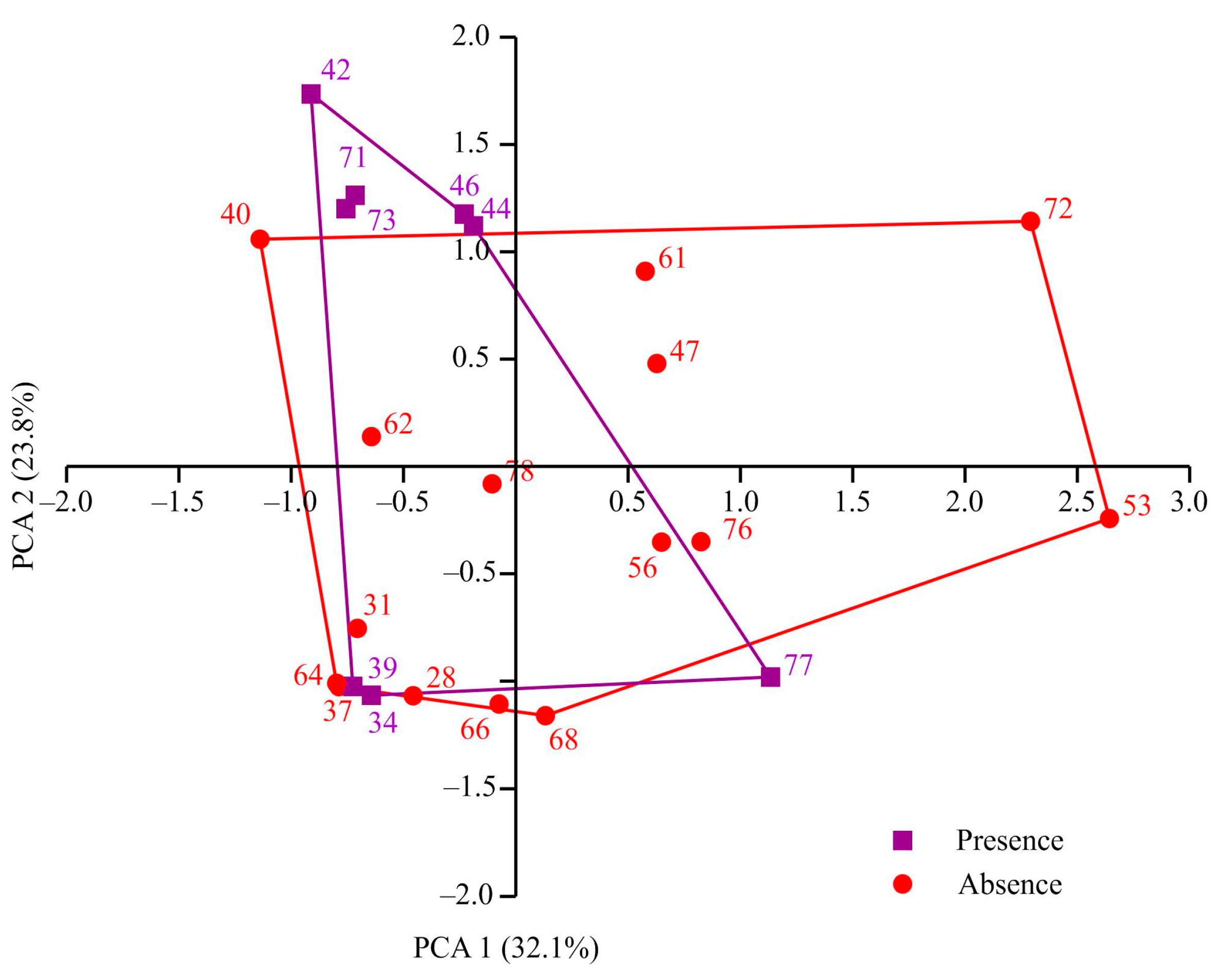
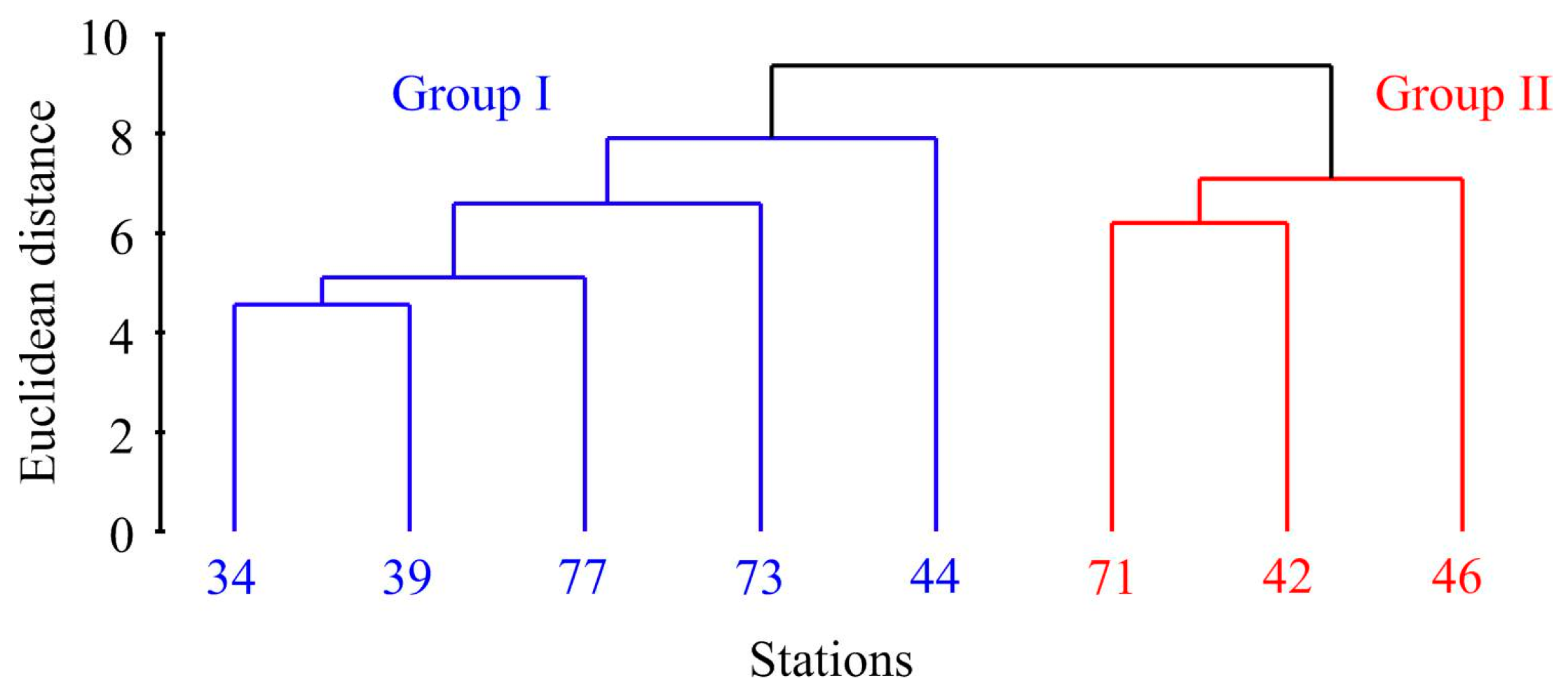

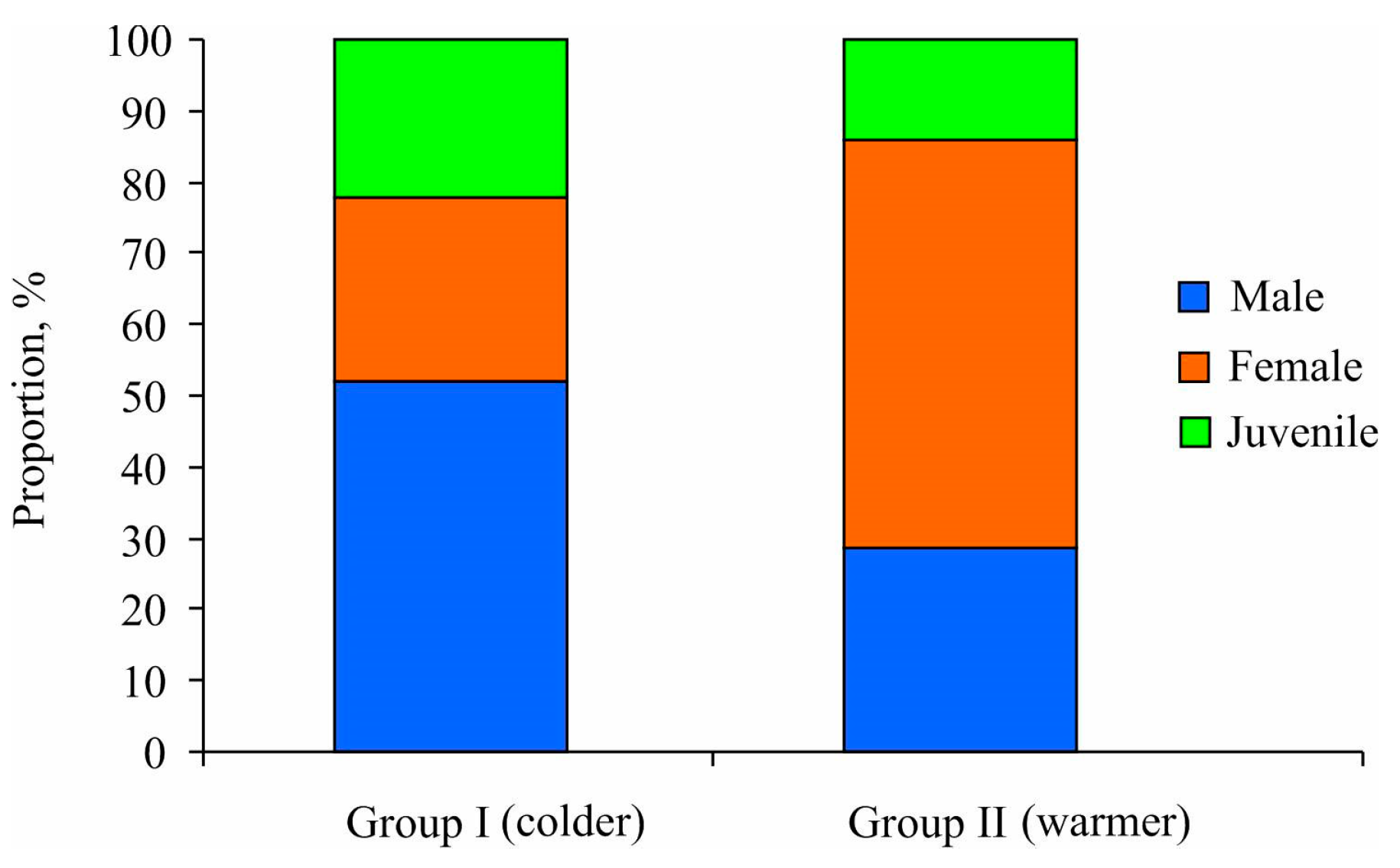
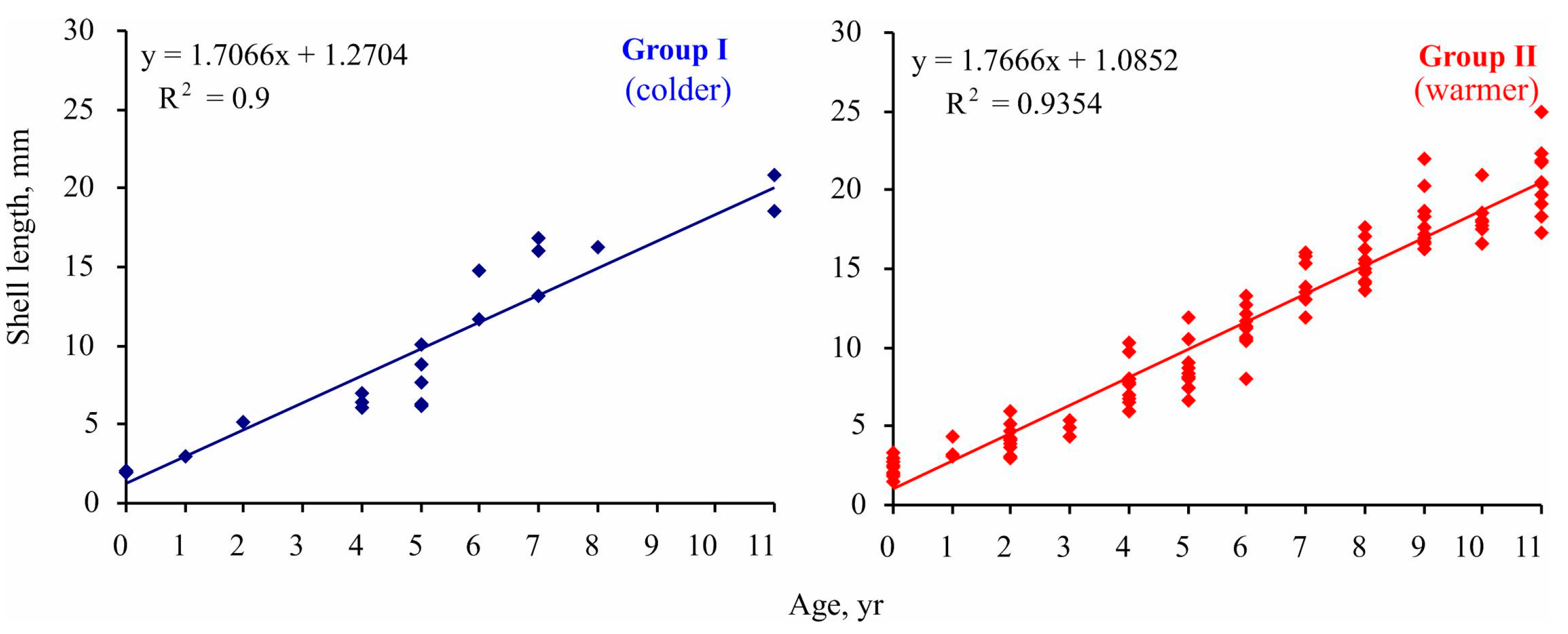
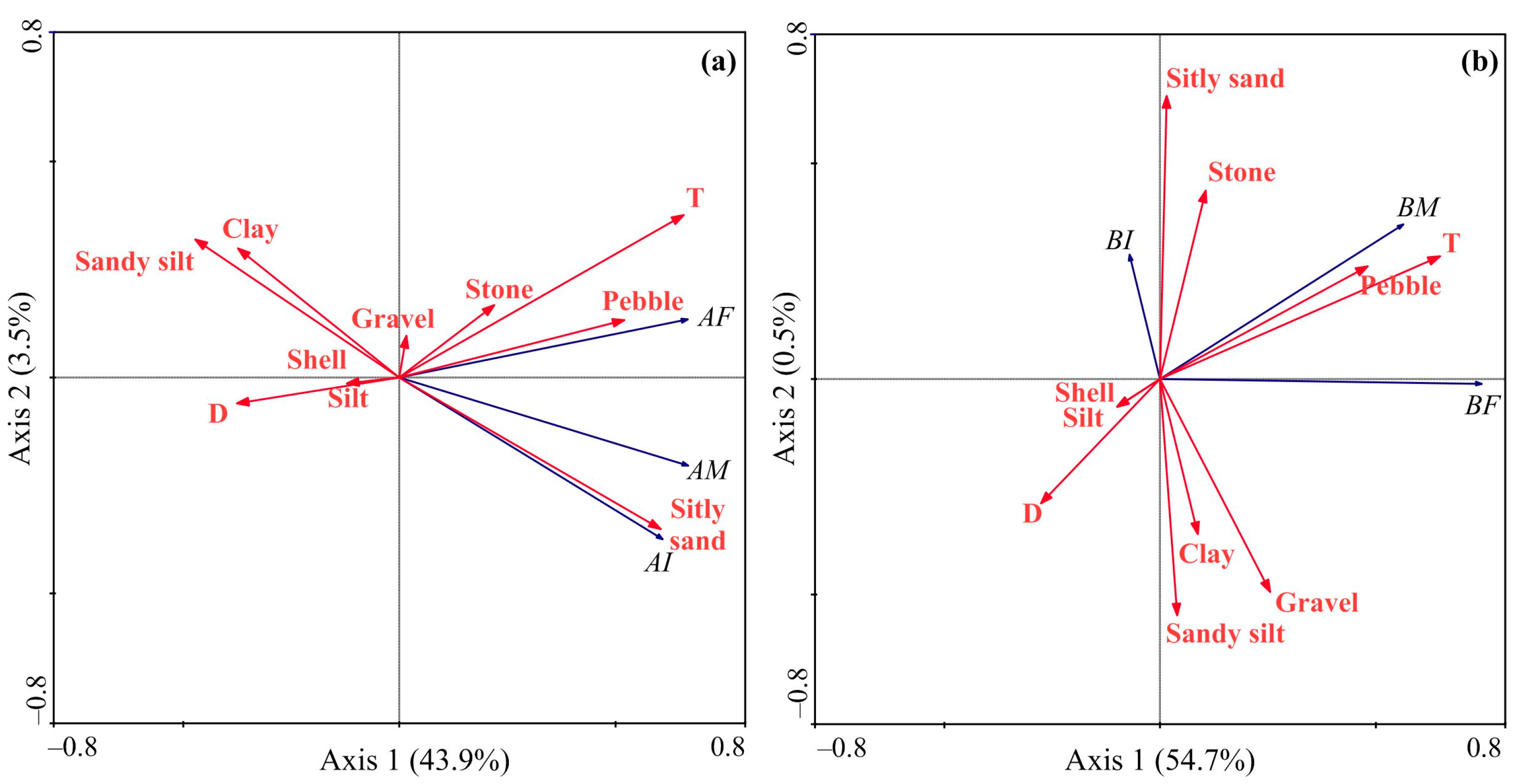
| Parameter | Group I (Colder) | Group II (Warmer) | ANOVAS Tatistics | |||||||
|---|---|---|---|---|---|---|---|---|---|---|
| X | SE | Min | Max | X | SE | Min | Max | |||
| F | p | |||||||||
| Abundance, ind. m−2 | 3.0 | 1.4 | 0.2 | 8.1 | 263.0 | 87.2 | 134.2 | 429.2 | 16.66 | 0.006 |
| Biomass, g m−2 | 19.9 | 5.9 | 6.6 | 36.6 | 178.8 | 64.8 | 96.6 | 306.6 | 10.99 | 0.016 |
| Shell length, mm | 9.9 | 1.7 | 6.8 | 16.4 | 19.5 | 3.9 | 12.1 | 25.1 | 7.19 | 0.036 |
| Mean age, yr | 4.8 | 0.7 | 3 | 7 | 11.3 | 2.3 | 7 | 15 | 11.05 | 0.016 |
| Variable | LambdaA | F | p | Variable | LambdaA | F | p |
|---|---|---|---|---|---|---|---|
| Abundance | Biomass | ||||||
| T | 20 | 5.09 | 0.020 | T | 23 | 6.30 | 0.012 |
| Pebble | 11 | 3.44 | 0.051 | Pebble | 13 | 3.88 | 0.045 |
| Silty sand | 5 | 1.43 | 0.221 | Clay | 9 | 3.06 | 0.105 |
| Shell | 7 | 2.19 | 0.156 | Silty sand | 3 | 1.21 | 0.287 |
| D | 2 | 0.67 | 0.407 | D | 5 | 1.81 | 0.181 |
| Clay | 2 | 0.50 | 0.501 | Stone | 1 | 0.31 | 0.608 |
| Stone | 0 | 0.11 | 0.829 | Gravel | 1 | 0.25 | 0.657 |
| Gravel | 0 | 0.02 | 0.967 | Shell | 0 | 0.09 | 0.765 |
| Silt | 1 | 0.04 | 0.871 | Silt | 0 | 0.06 | 0.775 |
Disclaimer/Publisher’s Note: The statements, opinions and data contained in all publications are solely those of the individual author(s) and contributor(s) and not of MDPI and/or the editor(s). MDPI and/or the editor(s) disclaim responsibility for any injury to people or property resulting from any ideas, methods, instructions or products referred to in the content. |
© 2024 by the authors. Licensee MDPI, Basel, Switzerland. This article is an open access article distributed under the terms and conditions of the Creative Commons Attribution (CC BY) license (https://creativecommons.org/licenses/by/4.0/).
Share and Cite
Noskovich, A.E.; Dvoretsky, A.G. Spatial Distribution and Growth Patterns of a Common Bivalve Mollusk (Macoma calcarea) in Svalbard Fjords in Relation to Environmental Factors. Animals 2024, 14, 3352. https://doi.org/10.3390/ani14233352
Noskovich AE, Dvoretsky AG. Spatial Distribution and Growth Patterns of a Common Bivalve Mollusk (Macoma calcarea) in Svalbard Fjords in Relation to Environmental Factors. Animals. 2024; 14(23):3352. https://doi.org/10.3390/ani14233352
Chicago/Turabian StyleNoskovich, Alyona E., and Alexander G. Dvoretsky. 2024. "Spatial Distribution and Growth Patterns of a Common Bivalve Mollusk (Macoma calcarea) in Svalbard Fjords in Relation to Environmental Factors" Animals 14, no. 23: 3352. https://doi.org/10.3390/ani14233352
APA StyleNoskovich, A. E., & Dvoretsky, A. G. (2024). Spatial Distribution and Growth Patterns of a Common Bivalve Mollusk (Macoma calcarea) in Svalbard Fjords in Relation to Environmental Factors. Animals, 14(23), 3352. https://doi.org/10.3390/ani14233352







